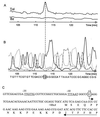Anaerobic toluene catabolism of Thauera aromatica: the bbs operon codes for enzymes of beta oxidation of the intermediate benzylsuccinate
- PMID: 10629170
- PMCID: PMC94273
- DOI: 10.1128/JB.182.2.272-277.2000
Anaerobic toluene catabolism of Thauera aromatica: the bbs operon codes for enzymes of beta oxidation of the intermediate benzylsuccinate
Abstract
The pathway of anaerobic toluene oxidation to benzoyl coenzyme A (benzoyl-CoA) consists of an initial reaction catalyzed by benzylsuccinate synthase, a glycyl radical enzyme adding the methyl group of toluene to the double bond of a fumarate cosubstrate, and a subsequent beta-oxidation pathway of benzylsuccinate. Benzylsuccinate synthase has been studied in some detail, whereas the enzymes participating in beta oxidation of benzylsuccinate are unknown. We have investigated these enzymes by analyzing substrate-induced proteins in toluene-grown cells. Toluene-induced proteins were identified and N-terminally sequenced. Nine of these proteins are encoded by an 8.5-kb operon consisting of bbs (beta-oxidation of benzylsuccinate) genes whose products are apparently involved in the beta-oxidation pathway of benzylsuccinate. Two of the genes, bbsE and bbsF, code for the subunits of a succinyl-CoA:benzylsuccinate CoA-transferase whose activity was previously detected in toluene-grown Thauera aromatica. The bbsG gene codes for a specific benzylsuccinyl-CoA dehydrogenase, as confirmed by overexpression of the gene in Escherichia coli and detection of enzyme activity. The further enzymes of the pathway are probably encoded by bbsH (enoyl-CoA hydratase), bbsCD (3-hydroxyacyl-CoA dehydrogenase), and bbsB (3-oxoacyl-CoA thiolase). The operon contains two additional genes, bbsA and bbsI, for which no obvious function could be derived. The bbs operon is expressed only in toluene-grown cells and is regulated at the transcriptional level. Promoter mapping revealed a transcription start site upstream of the bbsA gene. This represents the first known promoter site in Thauera spp.
Figures





Similar articles
-
Anaerobic toluene-catabolic pathway in denitrifying Thauera aromatica: activation and beta-oxidation of the first intermediate, (R)-(+)-benzylsuccinate.Microbiology (Reading). 1999 Nov;145 ( Pt 11):3265-3271. doi: 10.1099/00221287-145-11-3265. Microbiology (Reading). 1999. PMID: 10589736
-
(R)-Benzylsuccinyl-CoA dehydrogenase of Thauera aromatica, an enzyme of the anaerobic toluene catabolic pathway.Arch Microbiol. 2002 Dec;178(6):517-24. doi: 10.1007/s00203-002-0484-5. Epub 2002 Oct 8. Arch Microbiol. 2002. PMID: 12420174
-
Genes involved in the anaerobic degradation of toluene in a denitrifying bacterium, strain EbN1.Arch Microbiol. 2004 Mar;181(3):182-94. doi: 10.1007/s00203-003-0627-3. Epub 2004 Jan 21. Arch Microbiol. 2004. PMID: 14735297
-
Structure and Function of Benzylsuccinate Synthase and Related Fumarate-Adding Glycyl Radical Enzymes.J Mol Microbiol Biotechnol. 2016;26(1-3):29-44. doi: 10.1159/000441656. Epub 2016 Mar 10. J Mol Microbiol Biotechnol. 2016. PMID: 26959246 Review.
-
New tricks for the glycyl radical enzyme family.Crit Rev Biochem Mol Biol. 2017 Dec;52(6):674-695. doi: 10.1080/10409238.2017.1373741. Epub 2017 Sep 13. Crit Rev Biochem Mol Biol. 2017. PMID: 28901199 Free PMC article. Review.
Cited by
-
Redefining the coenzyme A transferase superfamily with a large set of manually annotated proteins.Protein Sci. 2022 Apr;31(4):864-881. doi: 10.1002/pro.4277. Epub 2022 Feb 7. Protein Sci. 2022. PMID: 35049101 Free PMC article.
-
Structural and Functional Characterization of an Electron Transfer Flavoprotein Involved in Toluene Degradation in Strictly Anaerobic Bacteria.J Bacteriol. 2019 Oct 4;201(21):e00326-19. doi: 10.1128/JB.00326-19. Print 2019 Nov 1. J Bacteriol. 2019. PMID: 31405915 Free PMC article.
-
Benzylsuccinate Synthase is Post-Transcriptionally Regulated in the Toluene-Degrading Denitrifier Magnetospirillum sp. Strain 15-1.Microorganisms. 2020 May 7;8(5):681. doi: 10.3390/microorganisms8050681. Microorganisms. 2020. PMID: 32392861 Free PMC article.
-
New Frontiers of Anaerobic Hydrocarbon Biodegradation in the Multi-Omics Era.Front Microbiol. 2020 Nov 16;11:590049. doi: 10.3389/fmicb.2020.590049. eCollection 2020. Front Microbiol. 2020. PMID: 33304336 Free PMC article. Review.
-
Stable Isotope and Metagenomic Profiling of a Methanogenic Naphthalene-Degrading Enrichment Culture.Microorganisms. 2018 Jul 10;6(3):65. doi: 10.3390/microorganisms6030065. Microorganisms. 2018. PMID: 29996505 Free PMC article.
References
-
- Aiba H, Adhya S, deCombrugge B. Evidence for two functional gal promoters in intact Escherichia coli. J Biol Chem. 1981;256:11905–11910. - PubMed
-
- Anders A, Kaetzke A, Kämpfer P, Ludwig W, Fuchs G. Taxonomic position of aromatic degrading denitrifying pseudomonad strains K172 and KB740 and their description as new members of the genera Thauera, T. aromatica sp. nov., and Azoarcus, A. evansii sp. nov., respectively, members of the beta subclass of Proteobacteria. Int J Syst Bacteriol. 1995;45:327–333. - PubMed
-
- Ausubel F M, Brent R, Kingston R E, Moore D D, Seidman J G, Smith J A, Struhl K, editors. Current protocols in molecular biology. New York, N.Y: John Wiley & Sons; 1987.
-
- Biegert T, Fuchs G, Heider J. Evidence that oxidation of toluene in the denitrifying bacterium Thauera aromatica is initiated by formation of benzylsuccinate from toluene and fumarate. Eur J Biochem. 1996;238:661–668. - PubMed
Publication types
MeSH terms
Substances
LinkOut - more resources
Full Text Sources
Other Literature Sources
Molecular Biology Databases
Miscellaneous

